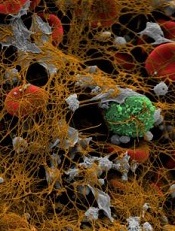
Andre E.X. Brown
After reviewing relevant studies, researchers have developed guidelines for the use of new oral anticoagulants (NOACs) in patients undergoing surgery.
The team analyzed 14 years’ worth of data and devised recommendations pertaining to apixaban, dabigatran, and rivaroxaban.
Their guidelines include recommendations for coagulation monitoring, reversing the effects of NOACs, stopping NOACs before surgery, resuming treatment after surgery, and managing bleeding complications.
Aida Lai, MBChB, of the North Bristol NHS Trust in the UK, and her colleagues detailed these recommendations in the British Journal of Surgery.
The researchers looked at studies published between January 2000 and January 2014 that reported on the use of apixaban, dabigatran, and rivaroxaban.
“As these drugs are still relatively new in the market, knowledge about how they work and their associated bleeding risks are still limited in the medical and surgical community,” Dr Lai said. “Our review covers recommendation for the discontinuation of new oral anticoagulant drugs before surgical procedures and resuming of these drugs after procedures.”
Monitoring coagulation
Dr Lai and her colleagues noted that routine coagulation monitoring is not required in patients on NOACs. However, physicians can use these tests to estimate the drugs’ anticoagulation effect in the event of bleeding, suspected overdose, or the need for emergency surgery.
For dabigatran, thrombin clotting time and ecarin clotting time can be used to test the anticoagulation effect. But prothrombin time (PT) is relatively insensitive to the drug, and sensitivity is variable with the activated partial thromboplastin time (APTT) assay. The diluted thrombin time (dTT) provides a direct assessment of thrombin activity, but the assay is not always available.
For rivaroxaban, PT has higher sensitivity than APTT, but there is variability among PT reagents. The anti-Xa chromogenic assay can help estimate the anticoagulation effect of rivaroxaban and apixaban, but this requires calibration with drug-specific reagents.
Reversibility of NOACs
The researchers pointed out that, as NOACs have short half-lives, drug concentrations will decline rapidly in patients with normal renal function. There are few options for reversing the effects of NOACs, but studies are underway investigating the use of antifibrinolytic agents and monoclonal antibodies.
Activated charcoal can decrease the absorption of dabigatran, and hemodialysis can eliminate it from the system, to a large extent. Research has shown that prothrombin complex concentrate (PCC) can reverse the anticoagulation effect of rivaroxaban, although only in healthy subjects thus far.
Discontinuing NOACs before surgery
The decision of when to discontinue NOACs before elective surgery depends on the procedure and the drug in question, Dr Lai and her colleagues said. Physicians must also take into account the individual patient’s risk of bleeding. Recommendations for discontinuation range from 18 hours to 5 days before surgery.
As for emergency and trauma surgery, withholding NOAC doses and initiating supportive care may be sufficient for most patients, due to NOACs’ relatively short half-lives. However, if possible, surgery should be deferred at least 12 hours, ideally 24 hours, from the last dose of a NOAC.
If a patient has taken dabigatran within 2 hours, oral activated charcoal can be used to decrease absorption. Physicians should also consider hemodialysis in patients on dabigatran who have impaired renal function and will require more time for drug clearance. But dialysis will likely be ineffective for clearing rivaroxaban or apixaban.
The researchers recommend the use of PCC or fresh-frozen plasma only in the event of severe hemorrhage. They recommend hemodynamic support in the presence of major bleeding and note that massively transfused patients may require plasma or platelets in addition to red blood cells. Activated PCC or factor VIIa should be considered a last resort.
Restarting NOACs after surgery
The researchers said NOACs can be restarted at a therapeutic dose 24 hours after procedures that confer a low bleeding risk and 48 to 72 hours after procedures that confer a high bleeding risk, as long as adequate hemostasis has been achieved.
If patients have undergone procedures associated with immobilization, they should be given low-molecular-weight heparins 6 to 8 hours after surgery, once hemostasis has been achieved. Then, they can receive NOACs 48 to 72 hours after the procedure.
Managing bleeding complications
NOACs pose a lower risk of intracranial bleeding than warfarin, but they also confer an increased risk of gastrointestinal bleeding. If any bleeding occurs, physicians should enquire about the exact time and amount of the patient’s last NOAC dose.
“As NOACs have short elimination half-lives, time is the most important antidote,” Dr Lai and her colleagues noted.
If the bleeding is not life-threatening, withholding the NOAC and initiating standard supportive measures, such as fluid resuscitation and hemostatic measures, may be sufficient. Patients may receive red cell and platelet transfusions if necessary. And fresh-frozen plasma is appropriate as a plasma expander but not as a reversal agent.
If a patient is experiencing severe or life-threatening bleeding, physicians should withhold the NOAC and initiate standard supportive measures. But they should also try to reverse the anticoagulant effect with activated PCC (50 units/kg) or PCC (25 units/kg) in the case of rivaroxaban and hemodialysis in the case of dabigatran.

